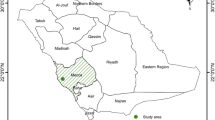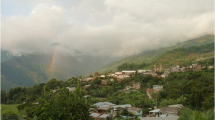Abstract
Quantifying Medicinal Plant Knowledge among Non–Specialist Antanosy Villagers in Southern Madagascar. Medicinal plant knowledge among non–specialist Antanosy villagers of southeastern Madagascar was investigated in a two–stage study. First, free–listing was used to collect the names of medicinal plants most familiar to local people. Data were organized by habitat and frequency into a short list of the 42 most frequently listed plants by habitat. A second group of interviewees were asked to name health conditions that could be treated with plants on the short list. Age, gender, and dwelling proximity to the forest were tested across the general habitat in which medicinal plants were found: in or near the village, in disturbed buffer areas between the village and the forest, or in the forest itself. Neither age nor gender was significant in free–listing. Naming health conditions treated with specific plants showed that knowledge increases with age and that for all but the oldest age group, women knew more plant uses than men. Women knew more plants from the village and buffer areas, and fewer from the forest than men. The proximity of the home to the forest had no influence on medicinal plant knowledge. The non–specialists interviewed named an average of 14 medicinal plants and most knew an average of 37 uses for 9 of the 42 most common medicinal plants. The most common conditions for people knew of plant treatments were stomach ache, babies’ fevers, and several unlisted conditions. Both exotic and endemic plant species were known to the non–specialists indicating that medicinal plant knowledge is being sustained and adapted to changes affecting both the people and their environment.
Quantifier la connaissance des plantes médicinales parmi les villageois Antanosy non–spécialistes dans le Sud Est de Madagascar. La connaissance des plantes médicinales chez les villageois Antanosy non–spécialiste du sud–est de Madagascar a été étudiée en deux étapes. Une Première listage libre a été utilisé pour recueillir les noms des plantes médicinales les plus familiers parmi la population locale. Les données ont été organisées par habitat et la fréquence dans une courte listes des 42 plantes les plus fréquemment mentionnés par les habitant. A un deuxième groupe de personnes interviewées, ont été demandé de nommer les maladie qui pourraient être traitées avec les plantes sur la liste restreint. Sexe, âge, et villages a proximité de la forêt ont été mis a l’essai à travers l’habitat général dans lequel les plantes médicinales ont été trouve: dans ou près du village, dans les zones tampons perturbée entre le village et la forêt, ou dans la forêt elle–même. Ni l’âge, et le sexe ont été significatifs dans le listage libre. En nommant les maladies traités avec des plantes spécifiques ont montré que la connaissance augmente avec l’âge pour tous, mais le groupe le plus âgé, et les femmes en savaient plus que les hommes. Les femmes vivant dans les zones tampon et les villages, en savaient plus sur les plantes, mais moins dans la zone forestier que les hommes. La proximité des habitats près de la forêt n’avait aucune influence sur les connaissance des plantes médicinales. Les non–spécialistes interrogés ont nommé une moyenne de 14 plantes médicinales et la plupart connaissaient, en moyenne, 37 utilisation sur 9 des 42 plantes médicinales les plus commun. Les usage les plus commun que les gens savaient des plantes été pour le traitement des maux d’estomac, de la fièvre des nourrisson, et une panoplie de conditions non listée: autres. Aussi bien les plantes exotiques et endémiques étaient connus des habitants non–spécialistes indiquant que la connaissance des plantes médicinales est soutenue et adaptée aux changements affectant à la fois la populations et leur environnement.


Similar content being viewed by others
Literature Cited
Alcorn, J. B. 1984. Huastec Mayan ethnobotany. Austin, Texas: University of Texas Press.
Alencar, N. L., T. A. S. Araujo, E. L. C. Amorim, and U. P. Albuquerque. 2009. The inclusion and selection of medicinal plants in traditional pharmacopoeias—Evidence in support of the diversification hypothesis. Economic Botany 64(1):68–79.
Bennett, B. C. and G. T. Prance. 2000. Introduced plants in the indigenous pharmacopeia of northern South America. Economic Botany 54(1):90–102.
Bernard, H. R. 1995. Research methods in anthropology: Qualitative and quantitative approaches, 2nd ed. Walnut Creek, California: Alta Mira Press.
Camou-Guerrero, A., V. Reyes-Garcia, M. Martinez-Ramos, and A. Casas. 2008. Knowledge and use value of plant species in a Rarámuri community: A gender perspective for conservation. Human Ecology 36(2):259–272.
Campos, R. T. and C. Ehringhaus. 2003. Plant virtues are in the eyes of the beholders: A comparison of known palm uses among indigenous and folk communities of southern Amazonia. Economic Botany 57(3):324–344.
Caniago, I. and S. Siebert. 1998. Medicinal plant ecology, knowledge and conservation in Kalimantan, Indonesia. Economic Botany 52(3):229–250.
Comerford, S. C. 1996. Medicinal plants of two Mayan healers from San Andres, Peten, Guatemala. Economic Botany 50(3):327–336.
Dewar, R. E. and H. T. Wright. 1993. The culture history of Madagascar. Journal of World Prehistory 7(4):417–466.
Durbin, J. 1990. An investigation of the role of the local community in the successful maintenance of protected areas in Madagascar. Unpublished Ph.D. Dissertation, The Durrell Institute of Conservation and Ecology (DICE), The University of Kent, Canterbury, Kent, United Kingdom.
Frechione, J., D. A. Posey, and L. Francelino da Silva. 1989. The perception of ecological zones and natural resources in the Brazilian Amazon: An ethnoecology of Lake Coari. Advances in Economic Botany 7:260–282.
Frei, B. O., O. Sticher, and M. Heinrich. 1996. Medicinal and food plants: Zapotec criteria for selection. Journal of Applied Botany 72:82–86.
Frei, B. O., O. Sticher, and M. Heinrich. 2000. Zapotec and Mixe use of tropical habitats for securing medicinal plants in Mexico. Economic Botany 54(1):73–81.
Hamilton, A. C. 2008. Medicinal plants in conservation and development: Case studies and lessons learnt. Salisbury, United Kingdom: Plantlife International.
Heinrich, M., A. Ankli, B. Frei, C. Weimann, and O. Stitcher. 1998. Medicinal plants in Mexico: Healers’ consensus and cultural importance. Social Science and Medicine 47:1863–1875.
Heinrich, M., A. Ankli, B. Frei, C. Weimann, and O. Stitcher, M. Robles, J. E. West, B. R. Ortiz de Montellano, and E. Rodriguez. 1998. Ethnopharmacology of Mexican Asteraceae (Compositae). Annual Review of Pharmacology and Toxicology 38:539–565.
IUCN 2010. 2010 IUCN Red List of Threatened Species. http://www.iucnredlist.org (14 December 2010).
Krejcie, R. V. and D. W. Morgan. 1970. Determining sample size for research activities. Educational and Psychological Measurement 30:607–610.
Lozada, M., A. Ladio, and M. Weigandt. 2006. Cultural transmission of ethnobotanical knowledge in a rural community of northwestern Patagonia, Argentina. Economic Botany 60(4):374–385.
Lucena, R. F. P., E. L. Ara, and U. P. Albuquerque. 2007. Does the local availability of woody Caatinga plants (Northeastern Brazil) explain their use value? Economic Botany 61(4):347–361.
Lyon, L. M. 1999. Villagers’ perceptions of the sustainability of current resource management practices in the Tsitongambarika Classified Forest of southern Madagascar. Unpublished thesis, Department of Natural Resource Sciences, Washington State University, Pullman, Washington.
Lyon, L. M. and L. H. Hardesty. 2002. Traditional tenure systems regulating forest product extraction and use by the Antanosy of Madagascar. Journal of Ethnobiology 22(2):273–284.
Lyon, L. M. and L. H. Hardesty. 2006. Traditional healing in the contemporary life of the Antanosy people of Madagascar. Ethnobotany Research and Applications 3(4):287–294.
Phillipson, P. B. and G. Schatz. 2008. Catalogue of the Vascular Plants of Madagascar. http://www.efloras.org/madagascar (14 December 2010).
Maffi, L. 2001. On biocultural diversity: Linking language, knowledge, and the environment. Washington, D.C.: Smithsonian Institution Press.
Nazarea, V. D. 1998. Cultural memory and biodiversity. Tucson, Arizona: The University of Arizona Press.
Neto, E. M., N. Peroni, and U. P. De Albuquerque. 2010. Traditional knowledge and management of Umbu (Spondias tuberosa, Anacardiaceae): An endemic species from the semi–arid region of northeastern Brazil. Economic Botany 64(1):11–21.
Posey, D. A. 1985. Native and indigenous guidelines for new Amazonian development strategies: Understanding biological diversity through ethnoecology. In: Changes in the Amazon Basin. Vol. I. Man’s impact on forests and rivers, ed., J. Hemming, 156–180. Manchester, United Kingdom: Manchester University Press.
Richard, A. F. and S. O’Conner. 1997. Degradation, transformation, and conservation: The past, present, and possible future of Madagascar’s environment. In: Natural change and human impact in Madagascar, eds., S. M. Goodman and B. D. Patterson, 406–418. Washington, D.C.: Smithsonian Institution Press.
Voeks, R. A. 1996. Tropical forest healers and habitat preference. Economic Botany 50(4):381–400.
Weller, S. C. and A. K. Rommey. 1988. Systematic data collection. Quantitative research methods, Vol. 10. Beverly Hills, California: Sage Publications. Inc.
World Health Organization. 2002. Traditional medicine—Growing needs and potential. WHO Policy Perspectives on Medicines 2:1–6.
Yineger, H. and D. Yewhalaw. 2007. Traditional medicinal plant knowledge and use by local healers in Sekoru District, Jimma Zone, Southwestern Ethiopia. Published online in the Journal of Ethnobiology and Ethnomedicine 3:24.
Author information
Authors and Affiliations
Corresponding author
Rights and permissions
About this article
Cite this article
Lyon, L.M., Hardesty, L.H. Quantifying Medicinal Plant Knowledge among Non–Specialist Antanosy Villagers in Southern Madagascar. Econ Bot 66, 1–11 (2012). https://doi.org/10.1007/s12231-011-9185-9
Received:
Accepted:
Published:
Issue Date:
DOI: https://doi.org/10.1007/s12231-011-9185-9




